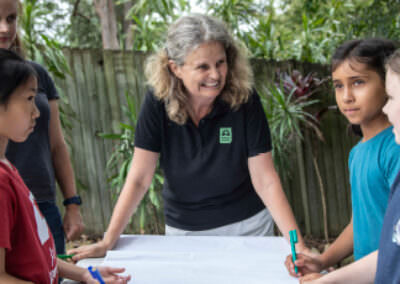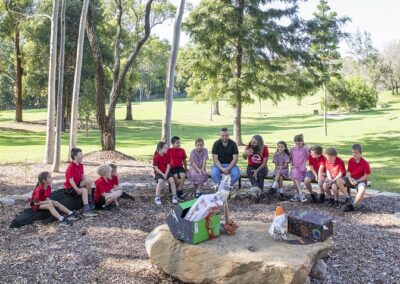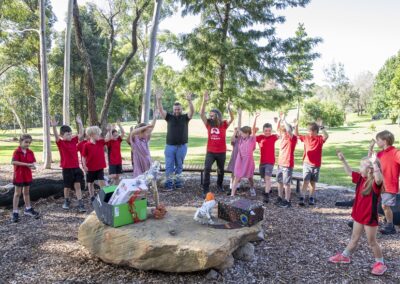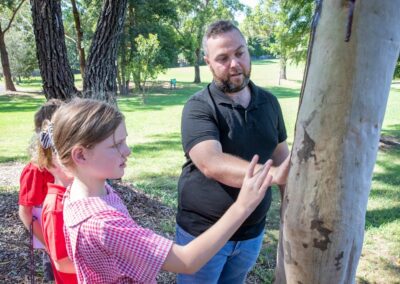
Creating a yarning circle: yarning and wellbeing
Time Allocation: 10-15 mins
Activity Level: Moderate
Introduction
In this learning activity we explore how yarning circles can be used for wellbeing based on the morning circle routine. However, there are many other ways you can use your yarning circle for wellbeing activities, for example, for dispute resolution, restorative practice and cultural sharing.
Being outdoors tends to allow us to slow down and reflect. A well set-up yarning circle can provide a welcoming atmosphere and can be utilised as a safe space to talk, share, discuss and have a yarn together; a place to build respectful relationships and enrich not just students' learning experiences but their overall sense of wellbeing in a natural setting.
It's also a great place to invite First Nations community members to share more about their Culture and run cultural activities like weaving, stories, Indigenous plant use and bushfood tasting, even cooking if the amenities are available; the meditative practice of weaving, art and cooking can also have positive effects on mental health.
Finally, providing First Nations students with an opportunity to showcase their Culture is an important way to create a better understanding of self and identity, which is a powerful tool in improving wellbeing; whilst exposing non-Indigenous children to Aboriginal and Torres Strait Islander Cultures is an important way to develop respect for diversity and Traditional Cultural Knowledge.
Checklist
Instructions
 Step 1
Step 1
Before you start:
Research morning circles, what they are used for and how they can be conducted. It could also be useful for you or members of your team to undertake professional development, such as the Berry Street Educational Model to give you more confidence in running this type of activity.
Morning circles are part of the daily routine and provide a consistent, predictable way to start the day and emphasise connectedness and belonging.
 Step 2
Step 2
Start your morning circle:
The morning circle can be led by the teacher or students as they learn how to run the circle.
Begin this activity with an Acknowledgement of Country. By acknowledging the Land, you are also making a promise that you will recognise the cultural practices of First Nations people.
 Step 3
Step 3
Create a positive start:
Start with a greeting that moves around the circle. This may include a fist-bump, gesture or similar. Include an Indigenous word from your area that is used as a greeting. (Use the research from the extension activity in Creating a yarning circle: Connecting with First Nations people for more information.)
Check in. This can be a response to a question such as, ‘How are we feeling?’ or ‘Are we ready to learn?’ Students can respond with a gesture or verbally. (This provides the teacher with an indication of where everyone is at and if further follow-up is required.)
Describe a value/trait/skill that you would like to focus on and how you would like to achieve this. Ask other participants in the circle to describe their own value/trait/skill that they would like to focus on today.
 Step 4
Step 4
Set up the day:
As a group, discuss the expectations for the day. Get feedback from the group about how the expectations can be met.
Make any announcements that will affect how the day will run and allow students to share important news/events such as birthdays.
Finish your morning circle with an activity such as a positive primer or brain break activity. This activity should be short, engaging and include the whole group. It could be:
- a short game
- investigating or observing a plant or animal in your yarning circle space
- brain teasers or puzzles.
Extension Activity
Use the yarning circle for Restorative Practice conversations, peer mediation and other conversations should they need to occur.